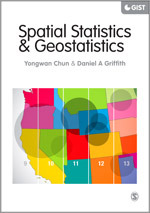Spatial Statistics and Geostatistics
Theory and Applications for Geographic Information Science and Technology
- Yongwan Chun - University of Texas at Dallas, USA
- Daniel A Griffith - University of Texas at Dallas, USA
GIS | Quantitative Methods in Geography | Quantitative/Statistical Research (General)
- Professor Tao Cheng, University College London
Focusing specifically on spatial statistics and including components for ArcGIS, R, SAS and WinBUGS, this book illustrates the use of basic spatial statistics and geostatistics, as well as the spatial filtering techniques used in all relevant programs and software. It explains and demonstrates techniques in:
- spatial sampling
- spatial autocorrelation
- local statistics
- spatial interpolation in two-dimensions
- advanced topics including Bayesian methods, Monte Carlo simulation, error and uncertainty.
It is a systematic overview of the fundamental spatial statistical methods used by applied researchers in geography, environmental science, health and epidemiology, population and demography, and planning.
A companion website includes digital R code for implementing the analyses in specific chapters and relevant data sets to run the R codes.
Supplements
Includes digital R code for implementing the analyses in specific chapters as well as relevant data sets to run the R codes.
This book is ideal for anyone who wishes to gain a practical understanding of spatial statistics and geostatistics. Difficult concepts are well explained and supported by excellent examples in R code, allowing readers to see how each of the methods is implemented in practice.
Professor Tao Cheng
University College London
This text is a remarkable roadmap to the methods of spatial statistics and in particular, the technique of spatial filtering. The included case studies and computer code make the book extraordinarily interactive and will benefit both students and applied researchers across many disciplines.
W. Ryan Davis
PhD Candidate in Economics, University of Texas at Dallas
This is a valuable and enjoyable addition to applied spatial statistics, particularly because the reader, or rather user, of the book can see exactly what the authors are doing, and so may reproduce all the analyses using the code provided.
Professor Roger S. Bivand
Norges Handelshøyskole Norwegian School of Economics
SAGE has a long tradition of publishing accessible texts explaining key concepts in statistics. This book is in my opinion very useful. I particularly like the choice of statistical problems, the focus on one region to explain a series of problems and the availability of R code, which makes it easy for the reader to reproduce the analysis.
Statistical software R is increasing its popularity in scientific community. Nowadays more and more researchers, geographers and GIS analysts are using R for spatial statistics. Therefore, it is important to provide geography and GIS students an opportunity to study also R applications as well. This textbook provides basic tools for applying R for spatial statistics. In addition, this book has brief examples and short strings of codes to apply. This book suites well to advanced level geography and GIS students which are interested in quantitative approach. Together, this book is handy also for PhD candidates utilizing spatial statistics in their work.
An introduction to R software is very short and I guess students have to know the basics of R before. On the other hand it is great that R code and all the necessary datasets are available online. Still it is too advanced for our students, mainly because they are not used to work in R yet.
The book spatial statistics and geostatistics is an essential resource for undergraduate and postgraduate students as well as early researcher, because the authors provide a comprehensive overview of spatial statistics and geostatistics. The book provides an excellent overview, supported by excellent examples. A really useful textbook.
The book is extremely well done, very clear and very helpful, but pretty much advanced. As we are currently developing R skills among students, we are likely to adopt the book in the near future, but for the moment it is too advanced.
The text is a supplementary reading for social sciences students, since it develops the statistical foundations behind most of the techniques employed in social sciences.
Too technical for this level
I quite liked this book and learned some useful things from it. However, it's also rather quirky (eclectic) and not always very clearly written. To me it lacked a clear sense of cohesion or logic to the chapters. Most annoyingly, as far as I can tell the data used in the book are not available anywhere - where to get it isn't mentioned - which renders the R code a bit pointless.
Sample Materials & Chapters
Chapter Five: Spatially Adjusted Regression and Related Spatial Econometrics







